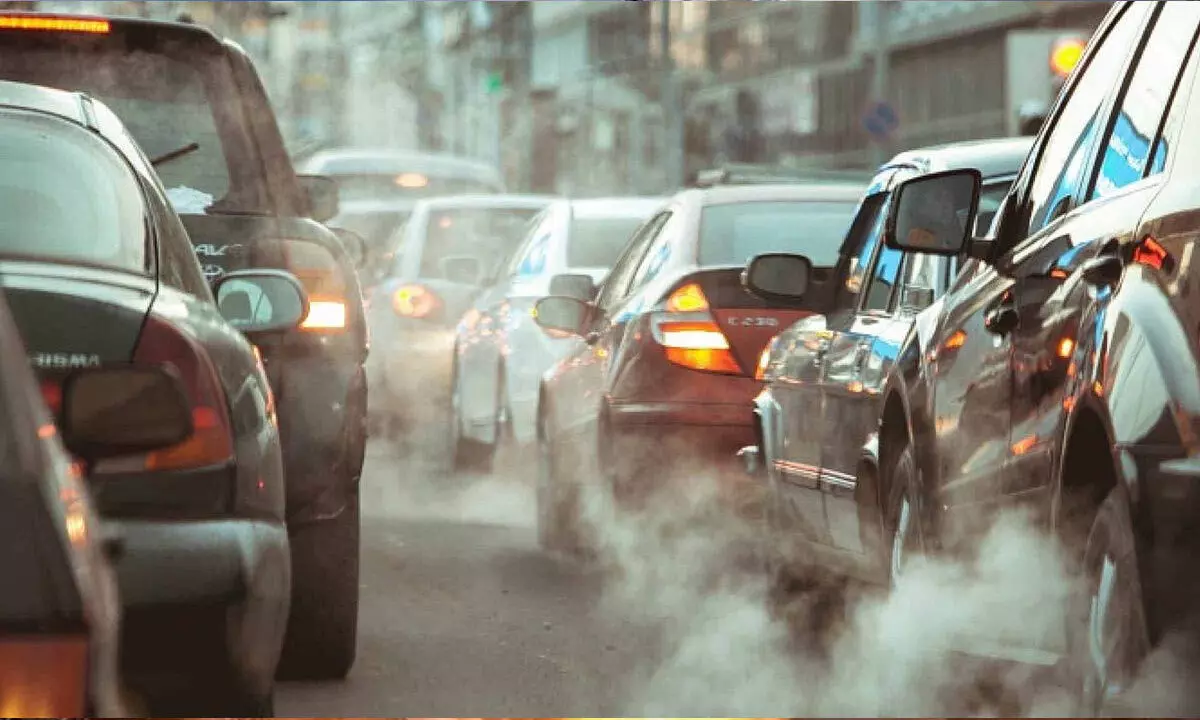Live
- NCC Day grandly celebrated at SITAM
- CITU demands rollback of strategic sale of VSP
- 7-Year-old girl sexually assaulted in Tirupati
- PM Modi highlights govt's efforts to make Odisha prosperous and one of the fastest-growing states
- Hezbollah fires 200 rockets at northern, central Israel, injuring eight
- Allu Arjun's Family Appearance on Unstoppable with NBK Breaks Viewership Records
- Unity of hearts & minds essential for peace & progress, says J&K Lt Governor
- IPL 2025 Auction: I deserve Rs 18 cr price, says Chahal on being acquired by Punjab Kings
- EAM Jaishankar inaugurates new premises of Indian embassy in Rome
- Sailing vessel INSV Tarini embarks on second leg of expedition to New Zealand
Just In
Real emissions much higher than lab tests


The report's release is timely, given the recent directive from the Supreme Court to finalise the Automotive Industry Standard (AIS) 170 and implement remote sensing in the National Capital Region. AIS 170 will set the technical parameters for remote sensing devices and equip authorities with the necessary resources to measure vehicle exhaust in real time
The real-world vehicle emissions are much higher thanlaboratory tests suggest and CNG vehicles, once considered a cleaner alternative, actually emit high levels of nitrogen oxides, according to a new study.
Conducted as part of The Real Urban Emissions (TRUE) Initiative in collaboration with authorities in Delhi and Gurugram, the study utilised non-intrusive remote sensing technology to measure the emissions of on-road vehicles. The study, conducted with technical analysis by the global think tank International Council on Clean Transportation (ICCT), revealed that nitrogen oxide (NOx) emissions from BS-VI private cars were 81 per cent lower than those from BS-IV cars. Similarly, BS-VI buses produced 95 per cent lower NOx compared to BS-IV buses.
The study also found that compressed natural gas (CNG) vehicle fleets emitted high levels of NOx, challenging the narrative of CNG being a "clean" alternative fuel. For example, Class II light goods vehicles emit up to 14.2 times their NOx lab limits while taxis emit four times the amount. This also means that to improve air quality, it is crucial to focus on the actual emissions from vehicles on the road, not just their lab results.
Commercial vehicles, such as taxis and light goods vehicles, emit much more NOx than private cars, even if they meet the same emission standards. "It is evident that real-world emissions from transport vehicles differ significantly from their laboratory values. For the first time in India, we have collected substantial emissions data from motor vehicles on the road. It is crucial to remember that what impacts our air quality is not the laboratory emissions but the pollutants released by these vehicles in operation," said ICCT India Managing Director Amit Bhatt.
"Therefore, it is time to rethink our emissions testing regime and aggressively push for the adoption of zero-emission vehicles," he added. FIA Foundation Deputy Director Sheila Watson said the research clearly showed India and the rest of the world that CNG was not the clean alternative fuel that was promised. "While Delhi struggles with dirty air, a visible killer hanging over the city, TRUE has shown that this less visible but still deadly fuel is not the solution. For health and for the climate, the answers to dirty air lie in switching to walking, cycling, and shared electric mobility," she said.
The report's release is timely, given the recent directive from the Supreme Court to finalise the Automotive Industry Standard (AIS) 170 and implement remote sensing in the National Capital Region. AIS 170 will set the technical parameters for remote sensing devices and equip authorities with the necessary resources to measure vehicle exhaust in real time.
"Remote sensing technology has the capability to non-intrusively screen tailpipe emissions from vehicles on a mass scale under real-world conditions and can help identify highly polluting vehicles. It is encouraging to see the Supreme Court and the (Union) Ministry of Road Transport and Highways moving forward with the implementation of this technology, beginning with the National Capital Region," said ICCT India researcher Anirudh Narla. "Remote sensing as an on-road surveillance method can not only help identify and remove the worst emitters but also helps understand emissions performance of different technologies and fuels. This shows that while the CNG transition has helped cut toxic particulate emissions from diesel vehicles during the early years, NOx emissions from on-road CNG vehicles without adequate controls can still be high. This builds a case for the next major transition to electrification to make tailpipe emissions not cleaner but zero," said Executive Director (Research and Advocacy) at the Centre for Science and Environment, India, Anumita Roychowdhury.
Meanwhile, there is a growing push to consider auto LPG (liquefied petroleum gas) as a more environmentally-friendly fuel option. It produces fewer harmful pollutants and could be a better alternative to CNG, according to proponents. The Indian Auto LPG Coalition (IAC) recently urged Union Environment Minister Bhupender Yadav to endorse auto LPG as an environmentally-friendly alternative fuel. In a letter to Yadav, IAC Director General Suyash Gupta said auto LPG, as a clean-burning fuel, significantly reduced emissions of harmful pollutants such as particulate matter, nitrogen oxides, and carbon dioxide, leading to improved air quality and a reduced carbon footprint.
This positions auto LPG as a "net zero hero", aligning with India's international environmental commitments, he said. "Auto LPG emits 20 per cent less CO2 compared to petrol and 60 per cent less than diesel. It produces almost no particulate matter, a major cause of air pollution, and has
significantly lower nitrogen oxide emissions. Auto LPG is also around 40 per cent cheaper than petrol, and the conversion cost for a petrol vehicle to auto LPG is around Rs 30,000, which is much lower than the conversion cost for an EV," he said.

© 2024 Hyderabad Media House Limited/The Hans India. All rights reserved. Powered by hocalwire.com






